11 Physics Questions for the New Century
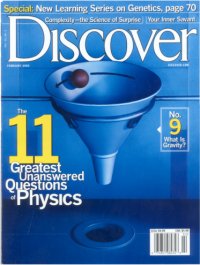 |
The February 2002 issue of Discover magazine based its cover story on the recent 105-page public draft of the National Research Council Committee on Physics of the Universe report, Connecting Quarks with the Cosmos: 11 Science Questions for the New Century.
The Discover article, "11 Greatest Unanswered Questions of Physics," by Eric Haseltine, tells a tale of modern physics about two scientists working in different fields—one studying huge objects far from Earth with the world's most powerful telescope, and the other studying tiny objects (particles) with the world's best microscope. As they focus their instruments on ever more distant and ever more minuscule objects, they begin to observe structures and behaviors never before seen—or imagined. They are excited but frustrated because their observations don't fit existing theories, so they begin to work together to find the answers.
In framing the report on which this article was based, the National Research Council's Committee on Physics of the Universe developed a list of 11 particularly direct questions about the cosmos, some of which have a good chance of being answered within the next decade. Each question reveals the interdependence between discovering the physical laws that govern the universe and understanding its birth and evolution and the objects within it. Approaching these questions from a perspective that includes both astronomy and physics requires a cross-cutting strategy that combines the tools and techniques of both disciplines—telescopes and accelerators, and space-based and ground-based instruments. Some research collaboration of this kind is already in motion between the two disciplines and among the three U.S. science funding agencies, the U.S. Department of Energy (DOE), NASA, and the National Science Foundation (NSF).
DOE's Office of High Energy and Nuclear Physics supports research on all 11 questions, as illustrated in the examples below.
1. What is dark matter?
Astronomers have shown that the objects in the universe from galaxies a million times smaller than ours to the largest clusters of galaxies are held together by a form of matter that is not what we are made of and that gives off no light. This matter probably consists of one or more as-yet-undiscovered elementary particles, and aggregations of it produce the gravitational pull leading to the formation of galaxies and large-scale structures in the universe. At the same time these particles may be streaming through our Earth-bound laboratories.
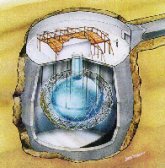 |
| The Sudbury Neutrino Observatory (SNO) in its underground cavern. |
Recent results from accelerator experiments at the Liquid Scintillator Neutrino Detector (LSND) at DOE's Los Alamos National Laboratory and underground detectors, Sudbury Neutrino Observatory (SNO) in Canada and Super-Kamiokande in Japan, give strong evidence that neutrinos "oscillate" among various types and must therefore have mass. Although it is a very small mass, the vast numbers of neutrinos in the universe could add up to a substantial total mass and contribute to dark matter in part. New accelerator experiments, MiniBooNE and MINOS at DOE's Fermi National Laboratory, will study neutrino oscillations and mass.
Other, as yet undiscovered, particles might exist; for example, a new symmetry called supersymmetry predicts a large new class of particles, some of which could explain dark matter. Experiments now running at the Fermilab Tevatron and planned for the Large Hadron Collider (LHC) under construction in Switzerland by CERN, the European Organization for Nuclear Research, will search for supersymmetric particles, as will experiments deep underground in the Cryogenic Dark Matter Search (CDMS) and in space with the Gamma-ray Large Area Space Telescope (GLAST).
 |
| AMS mounted on the space station |
The Alpha Magnetic Spectrometer is under construction and will be on the International Space Station starting in 2004 to search for any evidence of antimatter galaxies and for the mysterious dark matter that carries much of the mass of our galaxy. This project is led by the Massachusetts Institute of Technology (MIT) with worldwide collaboration in which the DOE and NASA play a significant role.
2. What is dark energy?
Recent measurements indicate that the expansion of the universe is speeding up rather than slowing down. This conclusion goes against the fundamental idea that gravity is attractive. If these measurements hold up, they require the presence of a form of matter dubbed "dark energy" whose gravity is repulsive rather than attractive.
 |
| Type Ia Supernova |
Detailed measurement of the rate of expansion can help distinguish among the various theoretical models that have been advocated to account for dark energy. Researchers at DOE's Lawrence Berkeley National Laboratory's (LBNL's) Supernova Cosmology Project are using data from observing Type Ia supernovae to obtain a direct measurement of the accelerating expansion of the universe. Large numbers of galaxies must be observed to study this type of supernovae since there is only one Type Ia supernova per galaxy every 400 years. This collaboration uses the Chilean telescope, the Keck telescope, and the Hubble telescope to observe and collect data on Type Ia supernovae.
Only 25 supernovae have been thoroughly studied to date, using the Hubble telescope, but in January 2003, a new effort dubbed "the Supernova Factory" will start using the Near Earth Asteroid Tracking (NEAT) telescope at Haleakala and Palomar I and II to obtain a Type Ia supernova near peak luminosity every other night. These observations will produce 50 gigabytes of data per night, which will be processed by the National Energy Research Supercomputing Center (NERSC) supercomputers in collaboration with the French Observations Group for Supernovae (FROGS).
 |
| Artist's conception of the SuperNova Acceleration Probe (SNAP) |
The NERSC supercomputers can produce simulations that will support other data-gathering methods leading to direct measurements of nucleosynthesis from the progenitor star, through the intermediate star during a supernova, to the core star after the supernova.
The simulations produced by NERSC supercomputers can also be used for the SuperNova Acceleration Probe (SNAP) satellite, another project led by the LBNL's Supernova Cosmology Project and the High-Z Supernova Search Team, which is under development to study the acceleration of the expansion of the Universe.
3. How were the heavy elements from iron to uranium made?
Scientist's understanding of the production of elements up to iron in stars and supernovae is fairly complete, but the precise origin of the heavier elements from iron to uranium remains a mystery.
 |
| RIA Conceptual Design (click for larger image). |
DOE supports theoretical and experimental studies of nuclear reactions that take place in supernovae as well as computer simulations of these violent stellar explosions. Much more information is needed about the extremely short-lived nuclei that take part in the complex chain of reactions. A new facility called the Rare Isotope Accelerator (RIA) has been proposed to study the full range of nuclei that can exist in nature. Data obtained from RIA, together with supernovae simulations using the most powerful computers available, will take scientists much closer to a full understanding of the origin of the heavy elements.
4. Do neutrinos have mass?
Cosmology tells us that neutrinos must be abundantly present in the universe today. Physicists have recently found increasing evidence that they have a small mass. There may even be additional types of neutrinos beyond the three of the current standard models.
 |
First results released from the Sudbury Neutrino Observatory (SNO) in Canada, combined with results of the Super-Kamiokande experiment in Japan, explain the missing solar neutrinos and add to the growing evidence that neutrinos have mass. Both experiments are international efforts with substantial support from DOE.
A long baseline neutrino detection experiment called MINOS is currently being assembled at Fermilab and in Minnesota, and a dedicated beam of neutrinos called NuMI is being built for it. With this new facility, Fermilab will have the opportunity to confirm early indications that the neutrino has a small mass and, if it does, to make precise mass measurements.
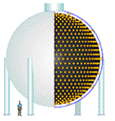 |
| MiniBooNE detector |
The Liquid Scintillator Neutrino Detector (LSND) at Los Alamos found evidence in 1995 that muon neutrinos change into electron neutrinos. A new detector at Fermilab called MiniBooNE will investigate this phenomenon, collecting much more data than LSND due to a stronger neutrino beam. The MiniBooNE neutrino beam will consist of high-intensity pulses about 10,000 times shorter than the LSND beam. This greatly improves the experiment's capability of separating beam-induced neutrino events from naturally occurring cosmic-ray nteractions, which take place at random times.
Our current theory assumes that neutrinos have no mass at all. A neutrino mass would require that the theory be modified and would help to explain at least part of the dark matter that makes up 90% of the universe.
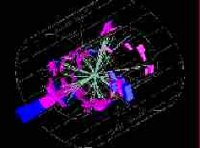 |
| Computer simulation of a Higgs boson event |
The source of mass for neutrinos, and all other leptons and quarks, is believed to be a unique interaction due to a "Higgs field," transmitted by the Higgs boson. This boson is the subject of an intense search at the Fermilab Tevatron. If not found at the Tevatron, the Higgs will probably be found at the CERN LHC, with substantial participation by DOE scientists."
5. Where do ultra-energy particles come from?
Physicists have detected an amazing variety of energetic phenomena in the universe, including beams of particles of unexpectedly high energy but of unknown origin. In laboratory accelerators, we can produce beams of energetic particles, but the energy of these cosmic rays far exceeds any energies produced on Earth.
 |
The 1,000 square mile Pierre Auger Observatory is an international project under construction to study very high energy cosmic rays. Colliding galaxies, like those at left, are mechanisms that form extremely high energy cosmic rays. The Pierre Auger Observatory in Argentina will be completed by 2003 and will boast a cosmic ray detector spread out over an area ten times that of Paris! The DOE and the NSF share equally in the U.S. contribution to the funding for the construction of the Auger Observatory Site in Argentina.
6. Is a new theory of light and matter needed to explain what happens at very high energies and temperatures?
Matter and radiation in the laboratory appear to be extraordinarily well described by the laws of quantum mechanics, electromagnetism, and their unification as quantum electrodynamics. The universe presents us with places and objects, such as neutron stars and the sources of gamma ray bursts, where the energies are far more extreme than anything we can reproduce on Earth in order to test these basic theories.
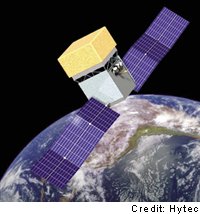 |
| GLAST in Orbit |
The Gamma Ray Large Area Telescope (GLAST) will open this high-energy world to exploration by observing high-energy gamma rays from many different astrophysical sources. GLAST will have an imaging gamma-ray telescope vastly more capable than instruments flown previously, as well as a secondary instrument to augment the study of gamma-ray bursts.
The universe is largely transparent to gamma rays in the energy range of GLAST. Energetic sources near the edge of the visible Universe can be detected by the light of their gamma rays. There is good reason to expect that GLAST will see known classes of sources to redshifts of 5, or even greater if the sources existed at earlier times. The small interaction cross sections for gamma rays also means that gamma rays can provide a direct view into nature's highest-energy acceleration processes. Gamma rays point back to their sources, unlike cosmic rays, which are deflected by magnetic fields.
With GLAST, astronomers will have a superior tool to study how black holes, notorious for pulling matter in, can accelerate jets of gas outward at fantastic speeds. Physicists will be able to study subatomic particles at energies far greater than those seen in ground-based particle accelerators. For this unique endeavor that brings astrophysics and particle physics research together, NASA is teaming with DOE and other institutions in France, Germany, Japan, Italy, and Sweden. The launch of GLAST is scheduled for March of 2006.
7. Are there new states of matter at ultrahigh temperatures and densities?
The theory of how protons and neutrons form the atomic nuclei of the chemical elements is well developed. At extremely high densities and temperatures, protons and neutrons may "dissolve" into an undifferentiated "soup" of quarks and gluons, which can be probed in heavy-ion accelerators. Still higher densities occur and can be probed in neutron stars and the early universe.
 |
| STAR detector image of thousands of particles emerging from a collision of gold nuclei at RHIC. |
The Relativistic Heavy Ion Collider (RHIC) is in operation at the DOE's Brookhaven National Laboratory to study of extremely hot, dense nuclear matter. It collides beams of gold nuclei at energies sufficient to form brief microcosms of the hot, dense soup of elementary particles (quarks and gluons) that previously existed only for the first microseconds after the Big Bang origin of our universe. The experimental data to date have revealed unexpected characteristics and provide the first tantalizing clues of possible quark-gluon plasma formation.
Physicists around the world are interested in the RHIC collisions, which occur thousands of times per second. Each one acts as a microscopic pressure cooker, producing temperatures and pressures more extreme than exist now even in the cores of the hottest stars. In fact, the temperature inside a RHIC collision can exceed 1,000,000,000,000 degrees above absolute zero—about ten thousand times the temperature of the sun. Although RHIC collisions may be super-fast and super-hot, which makes them interesting to physicists, they're too small and too brief to be dangerous.
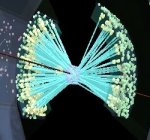 |
| PHENIX detector image of impact of two gold nuclei at RHIC |
In a RHIC experiment using the massive
PHENIX detector, the impact of two gold nuclei ejected fewer particles transverse to the collision axis than standard theory predicts. This is the first indicator of an exotic state of matter, but much more evidence is needed. By combining this finding with many to come in the next few years, researchers may be able to understand a state of matter that hasn't existed since the dawn of the universe.
8. Are protons unstable?
The matter of which we are made is the tiny residue of the annihilation of matter and antimatter that emerged from the earliest universe in not-quite-equal amounts. The existence of this tiny imbalance may be tied to a hypothesized instability of protons, the simplest form of matter, and to a slight preference for the formation of matter over antimatter built into the laws of physics.
Because it would imply the instability of all nuclear matter, the discovery of proton decay would be an historic event. Much effort has already been devoted to the search for proton decay. This was the principal original goal of the Kamiokande and the Super-Kamiokande detectors in Japan and the Irvine-Michigan-Brookhaven (IMB) and Soudan detectors in the United States. Though no protons were observed to decay, the scientists working there made impressive discoveries in neutrino physics, as mentioned previously in question #4.
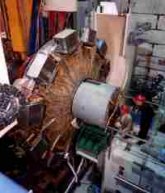 |
| BaBar detector at B Factory |
At the Stanford Linear Accelerator Center (SLAC), the B-Factory and its BaBar detector have an opportunity to explain the vast preponderance of matter over antimatter in the universe by studying B mesons. Electrons and positrons colliding at energies of several billion electron volts allow the study of an asymmetry in the way B mesons decay into other particles. The asymmetry is known as Charge-Parity (CP) violation and was first discovered in 1964. Still not fully understood, CP violation is believed to be at least partly responsible for the survival of more matter than antimatter after the Big Bang origin of the universe. Investigating this important asymmetry will also extend our understanding of elementary particles. B-factory physicists have already found striking differences between matter and anti-matter in the decays of the heavy, short-lived particles called B mesons.
9. What is gravity?
Black holes are ubiquitous in the universe, and their intense gravity can be explored. The effects of strong gravity in the early universe have observable consequences. Einstein's theory should work as well in these situations as it does in the solar system. A complete theory of gravity should incorporate quantum effects—Einstein's theory of gravity does not—or explain why they are not relevant.
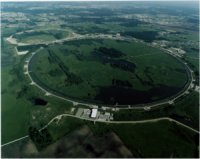 |
| Fermilab's Tevatron |
High energy and nuclear physics theorists study string theories and the possibility of extra spatial dimensions, which could help to explain quantum aspects of gravity. Experiments at high energy colliders like the Tevatron at Fermilab and LHC at CERN will be able to test some of these ideas in the next few years. String theories have already led to calculations of the entropy of black holes, a meeting place of quantum ideas and gravity.
10. Are there additional dimensions?
In trying to extend Einstein's theory and to understand the quantum nature of gravity, particle physicists have posited the existence of spacetime dimensions beyond those that we know. Their existence could have implications for the birth and evolution of the universe, could affect the interactions of the fundamental particles, and could alter the force of gravity at short distances.
The HENP's research into string theories suggests extra dimensions, as discussed in question #9. Experiments at the Tevatron and other colliders will search for evidence of extra dimensions by looking for missing energy in the particles produced in a collision of two accelerated particles, such as the proton and an antiproton at the Tevatron accelerator.
11. How did the Universe begin?
There is evidence that during its earliest moments the universe underwent a tremendous burst of additional expansion, known as inflation, so that the largest objects in the universe had their origins in subatomic quantum fuzz. The underlying physical cause of this inflation is a mystery.
 |
| Sloan Digital Sky Survey Telescope |
The Sloan Digital Sky Survey (SDSS) project, which observes the visible universe from a 2.5 meter telescope at Apache Point Observatory in New Mexico may shed some light on the inflation mystery after it completes its mission of systematically mapping one-quarter of the entire sky, producing a detailed image of it and determining the positions and absolute brightness of more than 100 million celestial objects. It will also measure the distance to a million of the nearest galaxies, giving us a three-dimensional picture of the universe through a volume one hundred times larger than that explored to date. Ultimately, it will give us an unprecedented knowledge of the distribution of matter to the edge of the visible universe. This will provide information about the primordial fluctuations in mass density, which should have been the result of inflation.
Related Web Links
Connecting Quarks with the Cosmos: 11 Science Questions for the New Century, draft report from the National Research Council Committee on Physics of the Universe
"A Lucky Catch: Oldest, Most Distant Supernova Confirmed by Supercomputer Analysis at NERSC," DOE Science News, DOE's Office of Science Website, April 2, 2001.
"Neutrino Measurements Surprises Fermilab Physicists," DOE Science News, DOE's Office of Science Website, January 28, 2002.
"Sky Survey Lowers Estimate of Asteroid Impact," DOE Science News, DOE's Office of Science Website, January 14, 2002.
Interactions of Matter, Space, and Time—Research at Fermilab: Fermilab's program overview of experiments regarding interaction of matter, space, and time includes the question of how to incorporate the study of quantum gravity into particle physics.
"Interactions, the Science of Matter, Space, and Time" High Energy Physics Advisory Panel (HEPAP) Briefing Book
"Signs of Quark-Gluon Plasma?" Physical Review Focus, American Physical Society (December 21, 2001).
"Stability of Protons", Inquiring Minds, Fermilab
Particle Physics for Regular People—Recommended Readings
Acronyms of High Energy Physics
RHIC Begins Colliding High-Energy Polarized Protons
Future Top Physics at the Tevatron and LHC
CDMS Experiment: THE CFPA CRYGENIC DARK MATTER SEARCH
Acknowledgements
More than one billion dollars per year is provided by the U.S. Department of Energy for high energy and nuclear physics research, involving about 3000 researchers and 1000 graduate students from more than 130 universities and 10 national laboratories. The DOE's Office of High Energy and Nuclear Physics manages this research within two divisions: High Energy Physics and Nuclear Physics.
The editor would like to thank the following individuals for assistance in compiling the information and reviewing the facts of this article:
Neil V. Baggett, Special Assistant for Policy and Communications, Office of High Energy and Nuclear Physics, DOE's Office of Science
David P. Goodwin, Physical Scientist, Office of High Energy and Nuclear Physics, DOE's Office of Science
Mike Riordan, DOE's Stanford Linear Accelerator Center
Peter Rosen, Associate Director of the Office of High Energy and Nuclear Physics, DOE's Office of Science
Robin Staffin, Deputy Associate Director for the Office of High Energy and Nuclear Physics, DOE's Office of Science
Back to Energy Science News